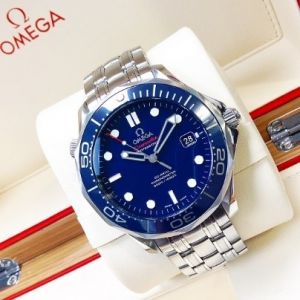The History of the Omega Watch
Here at Cuttings, we love delving into the history of our favourite watch manufacturers. The mighty Omega is no exception. Its name, the last letter of the Greek alphabet, signifies an achievement of perfection, and this ambition has been evident in Omega watches since their beginning.
1848 – The birth of OMEGA
Omega begins with a young Louis Brandt starting “La Generale Watch Co” in his family’s home, based in La Chaux-De-Fonds, Switzerland.
1879 – A family business
Louis Brandt sadly passes away at the age of 54. The business is left to his two sons, Louis-Paul and Cesar.
1880 – Moving home
The Brandt brothers decide to move the company from La Chaux-de-Fonds, starting at Route de Boujean but settling in Rue Jakob-Stampfli 96, Bienne.
1885 – Mass-production
Here in their new location, the brothers are able to launch “Labrador” – their first mass-produced calibre.
1892 – Wristwatches
Up until this point, the company focussed on pocket watches. In this year, they create the first wristwatch with minute-repeating functionality.
1894 – Omega calibre
Louis-Paul and Cesar Brandt develop a system that allows the interchanging of component parts – the Omega calibre was manufactured using this system.
1899 – Glowing reviews
Twelve Omega watches are sent to a British artillery officer, who sings their praises even after months of use in extreme weather conditions.
1900 – Award winning
The Universal Exposition’s Grand Prize is awarded to the Omega collection. The prestigious Parisian event celebrated innovation in the arts and sciences.
1901 – A break into motoring
Omega creates watches specifically for car and motorcycle fuel tanks.
1903 – A brand is born
Due to the success of the Omega brand watches, La Generale Watch Co. decide to start a spin-off company, founding the Omega Watch Co in this year.
1925 – Art Deco
Omega is awarded the Grand Prize at Paris’ Exposition Des Arts Decoratifs – where the Art Deco style is thought to have originated.
1929 – Shock resistant
This year sees the launch the robust Omega Armure wristwatch. The watch features a square case with a second protective case around the movement.
1931 – Refining the automatic movement
Omega makes a horological breakthrough in the form of an automatic movement that winds the movement in both directions, using two weights.
1932 – Diving watch
Before now, diving watches were not readily available to consumers. Omega introduces The Marine – the first commercially available watch of this kind.
1937 – Timepieces for royalty
An intricate Omega jewellery watch is presented to Dutch Princess Juliana on her wedding day by Federal Councillor Giuseppe Motta.
1948 – 100 years on
In its one-hundredth year, Omega launches its most famous model to date – the self-winding, super-waterproof Seamaster.
1955 – The Ladymatic
Omega introduces the first Ladymatic model, which is celebrated for its performance as well as it’s aesthetics.
1962 & 1965 – Omega in space
Astronaut Wally Schirra chooses to wear his Speedmaster for the 1962 Mercury Sigma 7 mission. In 1965, NASA approved the watch for all its manned flights.
1974 – The Marine Chronometer
The world’s very first marine chronometer is introduced by Omega. Even today, it’s the world’s most accurate wristwatch.
Omega has celebrated countless achievements throughout its history and continues to be a pioneer for modern horology. Why not take a look at the Omega models we currently have in stock at Cuttings?







